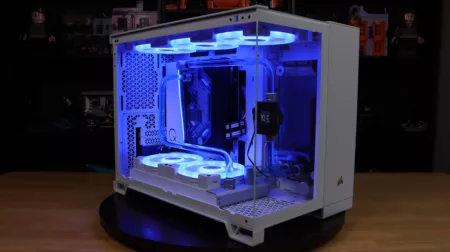The aftermarket CPU cooler scene right now is saturated by a lot of options. Air coolers in particular come in many different shapes and sizes, with the dual-tower design proving the most popular. For the most part of recent times, the Noctua NH-D14 is arguably the most popular option closely contested by other options. Recently though, Phanteks has made their presence felt with their flagship solution and immediately gained popularity. Today we have that exact product that surged Phanteks name skyward: the PH-TC14PE. Let’s see what this is all about, so read on and let’s make this showy!
Phanteks was relatively unknown until they burst into the scene a couple of months back with their product. With Noctua feeling the need to stick to their company colors which some people find visually appalling, those people have turned to Phanteks’ offering which had a more widely acceptable color scheme. More recently, Phanteks has released a wide array of color variants of their PH-TC14PE cooler and the one we have here is the black version which you’ll see more of later. With closed-loop liquid coolers gaining momentum on the market right now, we’ve felt it best to pit the TC14PE against something from the other side of the camp. We’ve went out and got a Corsair H1oo specifically for this review and we’re expecting a good fight from both products. Let’s check out some images first and specs before we get testing.
Phanteks was nice enough to include a third fan with this item which should come in handy in our testing. That said, the extra fan is not included in the original bundle so do note that.
Check out Phanteks’ website for more info at:Â http://www.phanteks.com/01/CPUcooler-PH-TC14PE.asp. One thing about the PH-TC14PE is that it comes in different colors and we’re particularly not sure how color may affect performance. For this test we have the the black version.
IMAGE GALLERY
Phanteks packages the PH-TC14PE in a square box with a some shots of the products and its various colors available. Features and details are enumerated on the other sides and we gotta say Phanteks has a way with words with their fancy tech terms.
The package includes two 140mm fans, the dual tower heatsink, documentation, the mounting and retention system for the heatsink and the fans, and a PWM fan header adaptor. Also included are a silicon strips and a tube of Phanteks’ own thermal paste.
The included fans are PH-F140 140mm fans rated for 1300RPM. As we’ve mentioned earlier, Phanteks offers the product in varying colors and similarly coplored fans are included in the package. Our black TC14PE includes fans with black fan blades.
The heatsink is of a twin tower design with two groups of fin stacks connected to 5 heatpipes that are pressed to the base.
The base has a partly textured surface and has curved tiny grooves on it. All in all though, the surface is of very fine craftsmanship and polish.
The fans are mounted via clips that secure the fans to the heatsink. Attaching the clips to the fans get tricky when you already have one side attached. Clips and accessories are included for attaching a third fan.
Here’s the cooler’s height for your reference. Note that the fans can be moved according to the user’s taste.
Memory modules with tall heatspreaders will most likely have clearance issues with the PH-TC14PE, we suggest using regular sized DIMMs or a tad lower than our HyperX Predators.
TESTING and RESULTS
Test Setup
| Processor | Intel Ivy Bridge Core i7 3770K overclocked to 4.4Ghz @1.26V |
| Motherboards | GIGABYTE G1.Sniper M3 |
| Cooling | Phanteks PH-TC14PE, Corsair H100 |
| Power Supply | Silverstone Strider Plus ST65F-P |
| Memory | Kingston HyperX Predator DDR3-2400 8GB |
| Video Cards | MSI GT620 |
| Storage | Kingston HyperX SSD 120GB |
| Operating System | Windows 7 64-bit SP1 |
Thanks to Tech Porn and Kingston Technologies Inc. for providing our testing equipment.
Before we get to testing, allow me a bit of background story. Our sample was provided by a friend who asked us to review the product and basing on current market status, we’ve thought that a showdown between a Noctua NH-D14 would end in a price/aesthetics match so we decided against that and went with the next best thing which is versus closed-loop liquid coolers and what better product to represent this camp than the 240mm radiator-clad Corsair H100. As a personal user of an H80 (it’s modded hence my insistence on getting an H100), we’d expect a fairly good out of the box showdown. Well things weren’t as nice as I’d have expected as the initial H100 unit we got (purchased) was found defective during our testing phase delaying our review. The problem was with the profile switch wouldn’t alter our fan speed and we were stuck with a jet engine. Corsair advises people who receive such unit to send them in for replacement which we gladly did and we received our unit a short while after which sadly had the same issue. Seeing as the unit itself is working, we felt that the an H100 at maximum setting would be an alright comparative so we pushed through with our testing. The primary concern, although irrelevant to this review, is Corsair’s quality control. Well that’s that. let’s get some heat pumping.
Our test system consists of that hot little Ivy Bridge chip called the i7-3770K, given again the circumstance that the majority of the users who might be interested or are using the PH-TC14PE are possible overclockers, we’ve OC’d our chip to 4.4Ghz with 1.26v. A 30-minute run of Prime95’s Blend Test is performed after a 30-minute idle period on a freshly installed copy of Windows. Temps are captured using RealTemp and AIDA Extreme 2.60’s CPU temp value. Peak values are recorded to present the absolute extremes that these coolers can achieve.
The Corsair H100 is tested, as mentioned, using only the maximum profile option which runs the fan at their maximum RPM. The stock TIM is used as well as the suggested fan orientation of push/exhaust config with the fan blowing over the rad, outside the top of the case. All tests were performed with a HAF922 with the top fan removed and no side panel. Ambient temps are 26-27*C.
The main highlight here is certainly the fanless operation as I’ve seen this processor spike upwards of 112*C on lesser heatsinks at the same voltage and frequencies so peaking at 95*C, although high is still impressive by my count. Do note that the Phanteks PH-TC14PE averaged at lower values and as you can see in the CPU sensor temp graph, the values are much more favorable. Adding more fan certainly improved the performance of the cooler with the tertiary fan still showing some gain.
As we’re impressed with the performance of the PH-TC14PE, we’re giving it a bit more to chew on. We take the triple fan setup and drive our voltage to 1.44v @4.8Ghz and load it up with Prime95 Small FFT torture test for 30 minutes.
I’d put up the H100 results for the higher OC test but it keeps throttling as the CPU cores goes past 105*C so we’re presenting you with the PH-TC14PE results only. I admit, our processor hates voltage and makes it known by putting out lots of heat. Fortunately, this is the first time I’ve seen this chip go 4.8Ghz stable without topping at 100+*C. Very impressive work from Phanteks’ cooler right here. Here’s the graph temperature graph as the test is being run:
CONCLUSION
Right off the bat, the Phanteks scores a victory over the Corsair H100 with our unit suffering from poor quality control with two different H100 units suffering from fan controller problems. Corsair is aware of this issue and will gladly replace the defective unit which they did but receiving another defective unit, both brand new, is very disappointing which led us to proceed with our tests with the given situation. So let’s start off with what’s great about the Phanteks PH-TC14PE: first up, mad props goes to Phanteks for the fanless results, easily handling our hot Ivy Bridge chip without any fan. WITHOUT ANY FAN. With every additional fan came better results but adding the third fan didn’t really show a large improvement aside from maybe increasing your e-peen size and/or case aesthetics if you’re into large chunks of metal and plastic blocking 50% of your motherboard (75% if you’re microATX, 100% if ITX.) Speaking of fans, Phanteks include very quiet fans which even at maximum speed is practically inaudible.
Now as for the negative aspects of the PH-TC14PE, we’re not gonna call into question the size and weight of the product. This is for the users’ consideration and they should know the issues accompanied with large tower heatsinks. What we’d like to point out is the installation procedure which was an absolute pain. Inside or outside the case, installing or removing the Phanteks PH-TC14PE is one laborious process and we’ll dock a point for quality on this one. Other than that, nothing else bad comes to mind.
At a purely performance standpoint, the PH-TC14PE is clearly a winner. As the majority of potential buyers of this product are enthusiasts or people seeking ultimate performance, we’re very sure they are already aware of the space requirements of these behemoth coolers and as such, we will not compare the space and visual appeal of competing products. If you’re already at this point of choosing over a NH-D14, a Silver Arrow or the PH-TC14PE, then you’re obviously past the point of closed-loop vs air-cooler so we’re skipping the obvious call that this cooler is ONE HUGE CHUNK OF METAL.That said, the Phanteks PH-TC14PE still does manage to make itself stand-out with a wide-variety of color options to suit many rig scheme. So in closing, we’re very pleased with the PH-TC14PE. Phanteks has created a very well-engineered product that even with laborious installation process and marketing fluff, comes out as a top performing cooler. If you are looking for a top-end air cooler, look no further than the Phanteks PH-TC14PE. It’s huge, cool (literally and figuratively) and also comes in black, Mr. Wayne. What more could you want? We give it our triple crown: Recommended, Editor’s Choice and GOLD Awards.
 Phanteks does not retail locally in the Philippines but Newegg prices puts it around 90USD, which for us, is a reasonable asking price for something that isn’t BROWN.






2 Comments
Hi Sir! Where can I buy this cpu cooler in the Philippines?
no idea bro, i got mine straight from Phanteks. Not sure pero i dont think they sold it here